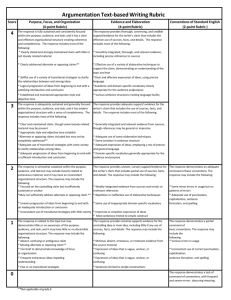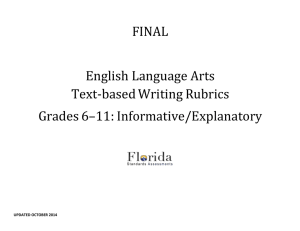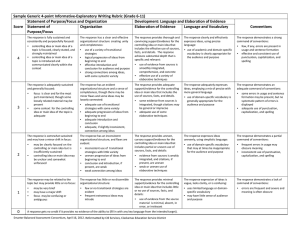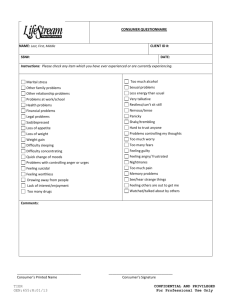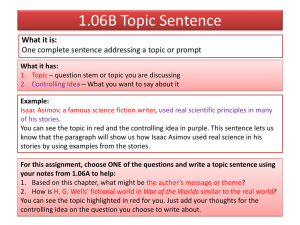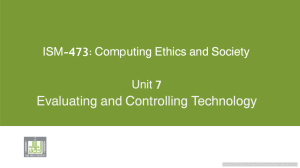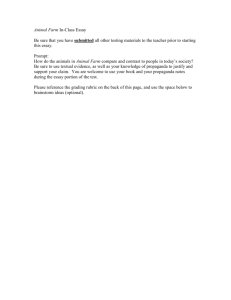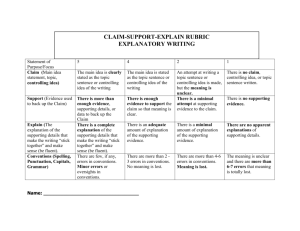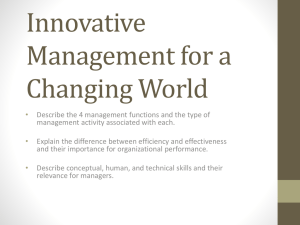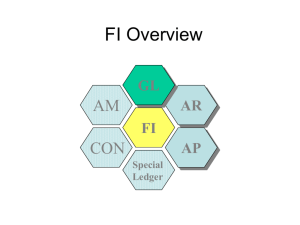Nov. 6th & 9th Objective Summaries of Theme Paragraph Frame
advertisement
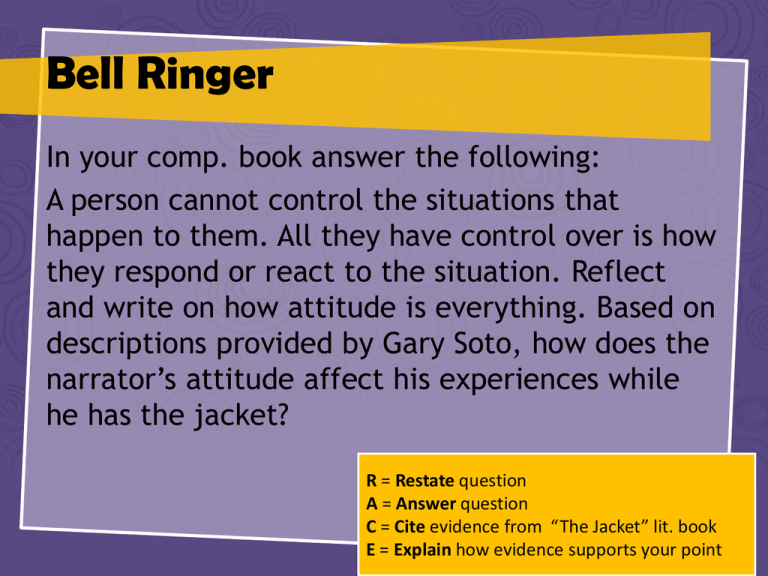
Bell Ringer In your comp. book answer the following: A person cannot control the situations that happen to them. All they have control over is how they respond or react to the situation. Reflect and write on how attitude is everything. Based on descriptions provided by Gary Soto, how does the narrator’s attitude affect his experiences while he has the jacket? R = Restate question A = Answer question C = Cite evidence from “The Jacket” lit. book E = Explain how evidence supports your point Housekeeping ANNOUNCEMENTS: • Remember, 6th grade late work policy for second quarter is two class periods for partial credit • Read to Succeed HOME LEARNING: • Achieve 3000: “Seeing Things in a New Way” (before reading poll + article + activity + thought question) due next class Today’s Objectives • Explain which details in the text support a given theme. • Summarize the story’s theme, keeping the summary free from personal opinions/judgments. • Infer the theme of a literary text based on the details in the text. Review • Check thinking & share out findings for the rest of “The Good Deed” by reviewing the conflict tracker. • Model how to write using sentence frames. “The Jacket” Independent Practice • Prompt: objectively summarize the key points of the story that aided the reader’s understanding of the central idea/theme. • Remember to: – RACE – Use sentence starters/sentence frames to help you get started – It won’t be exactly like “The Good Deed” because the theme’s are different, but the practice is close Grade 6 Informative/Explanatory Text-Based “The Jacket” Written Response Rubric Score 4 Purpose, Focus, and Organization (4-point Rubric) Evidence and Elaboration (4-point Rubric) Conventions of Standard English (2-point Rubric begins at score point 2) The response is fully sustained and consistently focused within the purpose, audience, and task; and it has a clear controlling idea and effective organizational structure creating coherence and completeness. The response includes most of the following: Strongly maintained controlling idea with little or no loosely related material Logical progression of ideas from beginning to end with a satisfying introduction and conclusion The response provides thorough and convincing support, citing evidence for the controlling idea or main idea that includes the effective use of sources, facts, and details. The response includes most of the following: Smoothly integrated, thorough, and relevant evidence, including precise references to sources Effective use of a variety of elaborative techniques (including but not limited to definitions, quotations, and examples), demonstrating an understanding of the topic and text Clear and effective expression of ideas, using precise language Academic and domain-specific vocabulary clearly appropriate for the audience and purpose The response provides adequate support, citing evidence for the controlling idea or main idea that includes the use of sources, facts, and details. The response includes most of the following: Generally integrated and relevant evidence from sources, though references may be general or imprecise Adequate use of some elaborative techniques Adequate expression of ideas, employing a mix of precise and general language Domain-specific vocabulary generally appropriate for the audience and purpose The response provides uneven, cursory support/evidence for the controlling idea or main idea that includes partial use of sources, facts, and details. The response may include the following: Weakly integrated evidence from sources; erratic or irrelevant references or citations Repetitive or ineffective use of elaborative techniques Imprecise or simplistic expression of ideas Some use of inappropriate domain-specific vocabulary The response provides minimal support/evidence for the controlling idea or main idea, including little if any use of sources, facts, and details. The response may include the following: Minimal, absent, erroneous, or irrelevant evidence or citations from the source material Expression of ideas that is vague, unclear, or confusing Limited and often inappropriate language or domain specific vocabulary N/A N/A Closing – Peer Check Writing 3 The response is adequately sustained and generally focused within the purpose, audience, and task; and it has a clear controlling idea and evident organizational structure with a sense of completeness. The response includes most of the following: Maintained controlling idea, though some loosely related material may be present Adequate progression of ideas from beginning to end with a sufficient introduction and conclusion 2 The response is somewhat sustained within the purpose, audience, and task but may include loosely related or extraneous material; and it may have a controlling idea with an inconsistent organizational structure. The response may include the following: Focused controlling idea but insufficiently sustained or unclear Uneven progression of ideas from beginning to end with an inadequate introduction or conclusion The response is related to the topic but may demonstrate little or no awareness of the purpose, audience, and task; and it may have little or no controlling idea or discernible organizational structure. The response may include the following: Confusing or ambiguous ideas Frequent extraneous ideas that impede understanding 1 0 N/A SCORE: N/A The response demonstrates an adequate command of basic conventions. The response may include the following: Some minor errors in usage but no patterns of errors Adequate use of punctuation, capitalization, sentence formation, and spelling The response demonstrates a partial command of basic conventions. The response may include the following: Various errors in usage Inconsistent use of correct punctuation, capitalization, sentence formation, and spelling The response demonstrates a lack of command of conventions, with frequent and severe errors often obscuring meaning _________/10 points
